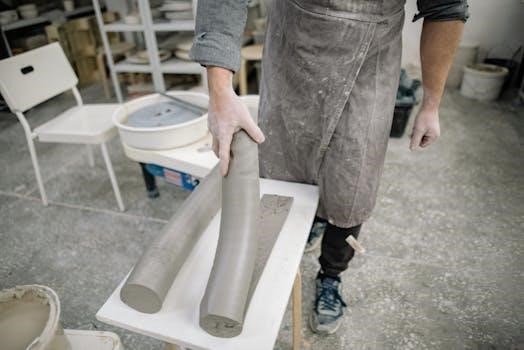Frigidaire Ice Maker Troubleshooting⁚ A Comprehensive Guide
Experiencing issues with your Frigidaire ice maker? This comprehensive guide provides clear instructions for diagnosing and resolving common problems. From basic maintenance to specific troubleshooting steps, we offer solutions to get your ice maker producing ice efficiently again. Follow our step-by-step advice for a quick fix.
Frigidaire ice makers, while generally reliable, can sometimes encounter issues that prevent them from producing ice as expected. It’s a common frustration when you reach for a cold drink only to find an empty ice bin. Before calling for professional repair services, it’s worth exploring some basic troubleshooting steps that can often resolve the problem quickly and easily. Many issues stem from simple oversights or easily corrected conditions.
This guide aims to provide you with a clear and concise approach to identifying and addressing the most frequent causes of Frigidaire ice maker malfunctions. We’ll cover everything from checking the power supply and water lines to inspecting the filter and troubleshooting the dispenser. Understanding the potential problems and their corresponding solutions can save you time and money. By following the steps outlined in this guide, you can confidently diagnose and resolve common issues, ensuring your Frigidaire ice maker continues to provide you with fresh, readily available ice. We will also direct you to the Frigidaire Ice Maker Troubleshooting Manual.
Checking the Ice Maker Switch
The first and often simplest step in troubleshooting a non-functioning Frigidaire ice maker is to verify the position of the ice maker switch. This switch controls the power supply to the ice maker and can sometimes be accidentally turned off, especially when reorganizing items in the freezer. Locating the switch is crucial, as its position varies depending on the specific Frigidaire model. It may be situated on the ice maker unit itself, inside the ice maker compartment, or even on the refrigerator’s control panel.

Once you’ve located the switch, ensure it’s in the “On” position. If the switch was indeed turned off, simply flipping it back on may be all that’s needed to restore ice production. Allow some time for the ice maker to cycle and begin producing ice. If the switch is already in the “On” position and the ice maker remains unresponsive, it’s necessary to further investigate the switch’s functionality. A multimeter can be used to check for continuity, confirming that the switch is properly conducting electricity. If the switch shows no continuity, it may be faulty and require replacement.
Verifying Power Supply
After confirming the ice maker switch is correctly positioned, the next essential step is to verify that the ice maker is receiving adequate power. This involves checking the power outlet the refrigerator is plugged into, ensuring that it is functioning correctly. A simple way to test the outlet is to plug in another appliance, such as a lamp or small kitchen device, to see if it powers on. If the outlet is not working, check the circuit breaker or fuse box to see if the corresponding breaker has tripped or the fuse has blown. Reset the breaker or replace the fuse as needed.
If the outlet is functioning properly, the issue may lie within the refrigerator’s power cord or internal wiring. Inspect the power cord for any visible damage, such as cuts, fraying, or exposed wires. If damage is evident, the power cord should be replaced by a qualified technician. Additionally, it’s important to ensure that the refrigerator is properly grounded, as a lack of grounding can sometimes interfere with the ice maker’s operation. If you suspect a wiring issue within the refrigerator itself, it is best to consult a qualified appliance repair professional to diagnose and resolve the problem safely.
Evaluating Freezer Temperature Settings
A critical factor in ensuring proper ice production is the freezer’s temperature setting. If the freezer is not cold enough, the ice maker will struggle to freeze water and produce ice efficiently. The ideal freezer temperature for ice production is typically around 0 degrees Fahrenheit (-18 degrees Celsius). If the temperature is set higher than this, adjust the freezer control to a colder setting.
Allow several hours, usually around 24 hours, for the temperature to stabilize after making adjustments. Use a thermometer to monitor the freezer temperature to ensure it reaches and maintains the optimal range. Avoid overcrowding the freezer, as this can restrict airflow and prevent proper cooling. Also, ensure that the freezer door is sealing tightly to prevent warm air from entering. Check the door gaskets for any signs of damage or wear, and replace them if necessary. If the freezer temperature consistently remains too warm despite adjustments, there may be an issue with the freezer’s cooling system, such as a faulty compressor or condenser fan, which would require professional repair. Regularly defrosting the freezer can also help maintain optimal temperature and ice production.
Addressing Water Supply Problems
A properly functioning water supply is essential for your Frigidaire ice maker to produce ice. If the ice maker isn’t receiving water, it cannot make ice, regardless of other factors. Start by ensuring that the refrigerator is properly connected to a working water line. Check the water supply valve, typically located behind the refrigerator or under the sink, to ensure it is fully open. If the valve is partially closed or clogged, the water flow will be restricted.
Next, inspect the water line itself for any kinks, bends, or damage that could be obstructing water flow. Straighten any kinks and replace any damaged sections of the water line. Also, verify that the water pressure to the refrigerator is adequate. The ice maker requires a minimum water pressure of 20 psi to operate correctly. If the water pressure is too low, you may need to consult a plumber to address the issue. If your Frigidaire refrigerator has a water filter, a clogged filter can also restrict water flow to the ice maker. Consider replacing the water filter to ensure proper water flow and optimal ice production. Following these steps can help resolve many water supply-related issues and get your ice maker working again.
Inspecting the Water Filter
The water filter in your Frigidaire refrigerator plays a crucial role in ensuring clean and fresh-tasting ice. Over time, the filter can become clogged with sediment, minerals, and other impurities, restricting water flow and affecting ice quality. Regularly inspecting and replacing the water filter is essential for maintaining optimal ice maker performance.
To inspect the water filter, locate it within the refrigerator compartment, typically in the upper right corner or near the bottom grille. Remove the filter according to the manufacturer’s instructions, noting the date of installation if applicable. Examine the filter for any signs of discoloration, debris, or damage. If the filter appears dirty or has been in use for more than six months, it’s time to replace it. A clogged water filter can significantly reduce water flow to the ice maker, leading to decreased ice production or no ice at all. Replacing the filter with a new, genuine Frigidaire filter ensures proper water flow and helps maintain the quality of your ice. Ensure the new filter is properly installed and seated according to the manufacturer’s instructions to prevent leaks and ensure optimal performance. Regularly replacing your water filter will help keep your ice maker running smoothly.
Troubleshooting Ice Dispenser Problems
If your Frigidaire ice dispenser is not dispensing ice properly, several factors could be at play. Before assuming a major malfunction, there are a few simple troubleshooting steps you can take. First, ensure that the ice bucket is correctly positioned and pushed all the way to the back of the shelf. An improperly seated ice bucket can prevent the dispenser mechanism from engaging.
Next, check for any obstructions in the ice chute or dispenser opening. Ice clumps or foreign objects can block the flow of ice. Carefully remove any visible obstructions. If the dispenser makes a humming sound but doesn’t dispense ice, the issue might be with the dispenser motor or auger. The auger is responsible for pushing ice from the bucket to the dispenser. A faulty motor or a jammed auger can prevent ice from dispensing. Inspect the auger for any ice buildup or debris that might be hindering its movement. If necessary, defrost the ice bucket to melt any frozen clumps. If the problem persists, the dispenser motor may need to be replaced by a qualified technician. Also, verify that the dispenser lock function is not activated, as this will prevent ice dispensing.
Dealing with Ice Clumping
Ice clumping is a common issue in Frigidaire ice makers, often resulting in a large, frozen mass instead of individual cubes. This problem can be frustrating, but it’s usually easily resolved. One of the primary causes of ice clumping is temperature fluctuation within the freezer. If the freezer temperature isn’t consistently cold enough, the ice can partially melt and refreeze, causing the cubes to stick together. Ensure that your freezer temperature is set to the recommended level, typically around 0 degrees Fahrenheit (-18 degrees Celsius).
Another factor contributing to ice clumping is infrequent use of the ice maker. When ice sits in the bin for extended periods without being used, it can gradually fuse together. To prevent this, try to use the ice regularly or empty the ice bin periodically to refresh the ice supply. Additionally, check the water filter. A clogged or dirty water filter can lead to irregular ice formation, making the ice more prone to clumping. Replace the water filter every six months, or as recommended by the manufacturer. If you notice excessive moisture in the ice bin, it could indicate a problem with the freezer’s defrost cycle. In such cases, manually defrosting the ice maker and freezer might help resolve the issue.

Checking for Obstructions in the Ice Maker Arm
The ice maker arm, also known as the shut-off arm or feeler arm, plays a crucial role in regulating ice production in your Frigidaire refrigerator. This arm senses the ice level in the bin, and when the bin is full, it signals the ice maker to stop producing ice. If the arm is obstructed, it can lead to continuous ice production, resulting in an overflowing ice bin and potential malfunctions.
Begin by visually inspecting the ice maker arm for any obstructions. Common culprits include ice cubes that have become dislodged or frozen together, food particles, or even small items that may have accidentally fallen into the ice maker compartment. Gently remove any visible obstructions, ensuring not to damage the arm itself. The arm should move freely up and down. If the arm is frozen in place, carefully use a hairdryer on a low setting to melt the ice, allowing the arm to move. Also, ensure the ice bin is properly positioned. If the bin is not pushed all the way to the back, it can interfere with the arm’s movement. After clearing any obstructions, manually test the arm to ensure it moves smoothly and triggers the ice maker to stop producing ice when raised. If problems persist, the arm itself might be faulty and need replacement.

Defrosting the Ice Maker
A common issue that can plague Frigidaire ice makers is ice buildup, which can prevent the unit from functioning correctly. Defrosting the ice maker is a simple yet effective way to resolve this problem. Ice accumulation can obstruct the ice-making mechanism, freeze the water supply line, or cause ice clumps, rendering the ice maker useless. Regular defrosting can prevent these issues and maintain optimal performance.

To defrost your Frigidaire ice maker, begin by turning off the ice maker using the on/off switch, typically located on the unit itself or the refrigerator’s control panel. Next, empty the ice bin to prevent the melted ice from refreezing into a solid block. You can then manually defrost the ice maker by leaving the freezer door open for a few hours, allowing the ice to melt naturally. To expedite the process, you can use a hairdryer on a low setting to gently melt the ice buildup, being careful not to damage any plastic components. Another method is to use a warm cloth to wipe down the ice maker, gradually melting the ice. Once all the ice has melted, thoroughly dry the ice maker and ice bin before turning the ice maker back on. Allow the ice maker several hours to begin producing ice again.
Resetting the Ice Maker
If you’ve tried various troubleshooting steps and your Frigidaire ice maker is still not functioning correctly, resetting the unit might be the solution. Resetting the ice maker can clear any internal errors or glitches that may be preventing it from operating properly. This process essentially restarts the ice maker, allowing it to recalibrate and resume its normal ice-making cycle.
To reset your Frigidaire ice maker, first locate the reset button. On many models, this button is found on the control panel, often labeled “Reset” or indicated by a specific symbol. Press and hold the reset button for approximately 3-5 seconds. You should hear a chime or see a light indicating that the ice maker has been reset. If your model doesn’t have a dedicated reset button, you can try unplugging the refrigerator for about 5-10 minutes and then plugging it back in. This will effectively reset the entire refrigerator system, including the ice maker. After resetting the ice maker, give it some time to restart its ice production cycle. It may take up to 24 hours for the ice maker to produce a full batch of ice. If the ice maker still doesn’t work after resetting, further troubleshooting or professional assistance may be required.
